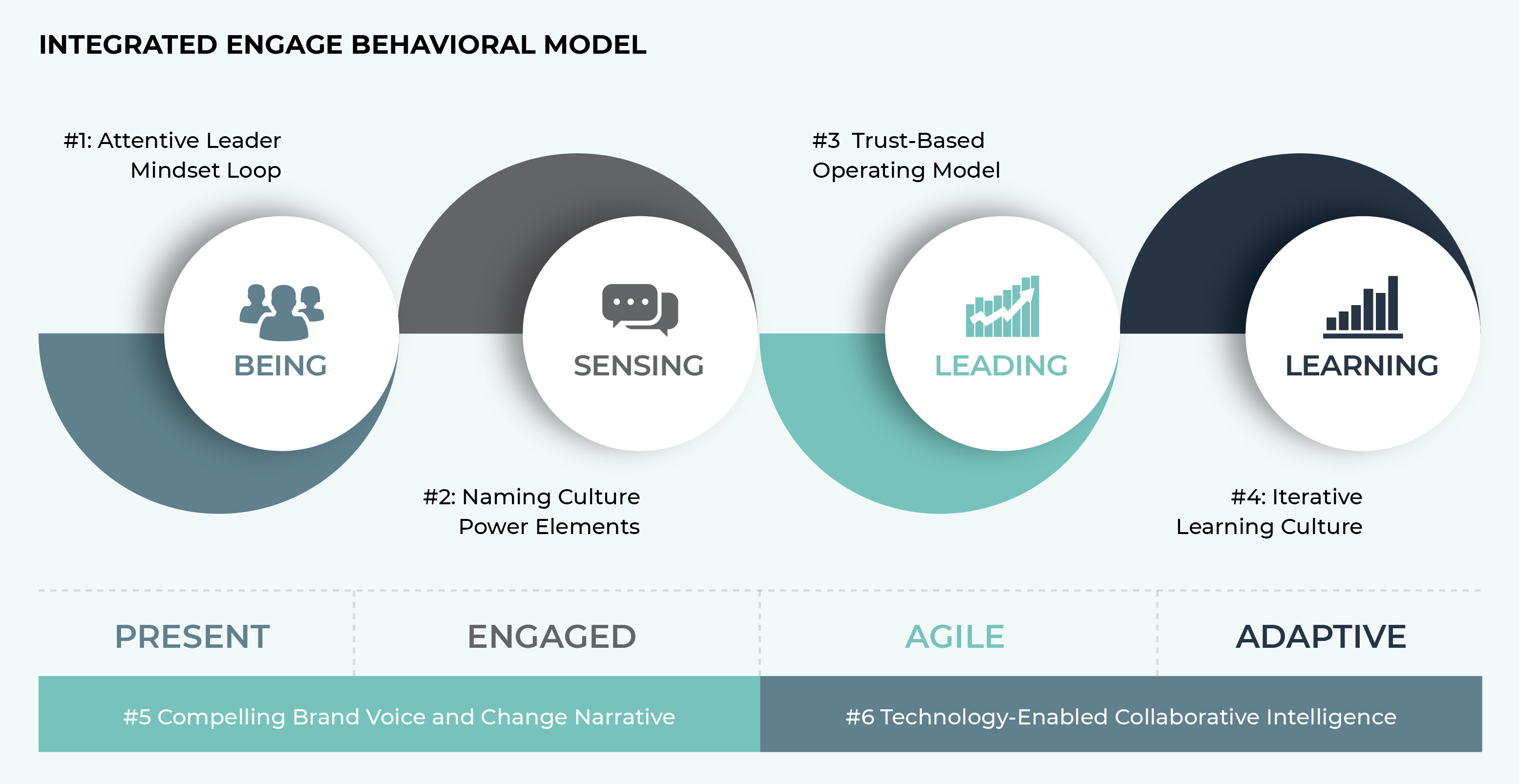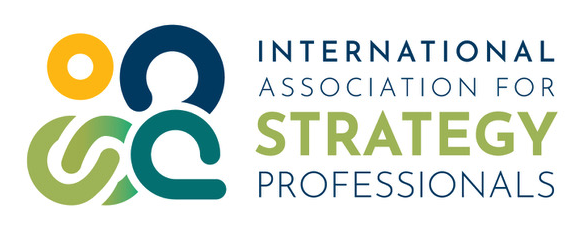By Gaye Clemson and Dana De Nault
Abstract
As shared by Pierre Hadaya and Bernard Gagnon in their 2020 Strategy Magazine article, Mapping an Agile Future, the purpose of strategy engagement activities is to build employee commitment and remove barriers to making strategies actually work. The authors demonstrate how organizations must master the five activities of “formulate, implement, execute, engage, and govern” to build a strategic managements system for durable success. Within this framework, experience suggests that engage success requires communicating in ways that inspire and inform, building trust quickly and cultivating multiple feedback mechanisms. The objective of this article is to share a leadership mindset and related set of agile behaviors we evolved over several years to enable one of the world’s largest network infrastructure providers to reap maximum benefits from its strategy engagement activities.
As shared by Pierre Hadaya and Bernard Gagnon (2020) in their recent Strategy Magazine article, ‘Mapping an Agile Future’, the purpose of strategy engagement activities is to build employee commitment and remove barriers to making strategies actually work.
The authors demonstrate how organizations must master the five activities of “formulate, implement, execute, engage, and govern” to build a strategic managements system for durable success. Within this framework, our experience suggests that engage success requires communicating in ways that inspire and inform, building trust quickly and cultivating multiple feedback mechanisms. Indeed, a 2019 Gallup assessment of the global workforce continued to report that just 15% of employees are highly involved in and enthusiastic about their work and workplace, but as many as 18% are actively disengaged. This is an alarming statistic and assembled before the ravages of the current COVID-19 pandemic. The objective of this article is to share a leadership mindset and related set of agile behaviors we evolved over several years to enable one of the world’s largest network infrastructure providers to reap maximum benefits from its strategy engagement activities.
Six Key Engagement Techniques
With more that US$ 50 billion, over 76,000 employees worldwide and likely half again as many outsourced contractors, our Fortune 100 high-tech client had been committed to a new software and services business model for some time. However, it wasn’t until 2016 that a ‘strategic cliff’ appeared, forcing its core enterprise networking business to move away from a pure hardware and services maintenance play and into the direction of software-defined access technology, post-sales customer success lifecycle motions and subscription software licensing business models. The impact of these changes on the company’s culture was enormous. Leadership at all levels needed to quickly shift to an agile and adaptive way of working that included:
- Integrating hardware, software, and services into value-based solutions that were aligned to each customer’s unique technology journey.
- Enabling continuous innovation release cycles.
- Designing and executing recurring revenue (subscription) licensing approaches.
- Engaging partners and related ecosystems with new operating models.
To enable our client to successfully transform itself and execute this new strategy, six key engagement techniques were devised and deployed over time. We framed these through a lens of four important behavioral constructs namely being, sensing, leading, and learning as illustrated in Figure 1 below.
Technique #1: Leveraging an Attentive Leader Mindset Loop
Leveraging a host of thought leaders in applied psychology our focus was to help team members become more present, engaged, agile, and adaptive. This meant advancing and mastering an Awareness-Action-Reflection Leader Mindset Loop. For awareness, training and mentoring in using self-as-instrument to understand one’s leadership context was essential. Action elements involved attention to one’s presence, trustworthiness and shifting leadership style to meet the demands of the moment. Reflection involved proactive use of the ‘Attentive Pause©’ process to assess self and team performance. Supported by formal toolkits, training, ground rules, knowledge libraries, and technologies, teams and individuals became engaged, agile and adaptive. This approach enabled the blossoming of creative ideas that might in the past have never emerged. As one leader shared: “One of the things that the process brought was trusted relationships cross functionally that one would not have had otherwise, and the sharing of information and concerns. This notion that anybody could put an idea in the center of the table and everyone could inspect it and pick it apart and ask the hard questions, without it getting personal was critical.”

Figure 1: The Integrated Engage Behavior Model
Technique #2: Naming the Power Elements of the Existing Culture
The most important technique that emerged over time was the naming of the power elements of the organization’s existing culture, which could help or hinder the transformational strategy. If these had been identified and managed proactively earlier it would likely have accelerated this change initiative. In other words, we had to learn what culture expert Edgar Shein meant when he wrote that culture change won’t happen unless leadership makes explicit the macro and micro cultural influences, underlying cultural artifacts, and deeper tacit assumptions that support shared organizational beliefs. This requires a deliberate culture assessment, where leadership compares espoused organizational values with witnessed leadership behavior and determines where gaps exist. From there, specific steps can be advanced in the change strategy to address these inconsistencies and reduce resistance to the overall change initiative.
Technique #3: Orchestrating a Trust-Based Operating Model
This effort involved empowering a new cross-functional ‘braintrust’ of leaders based on trust, transparency, empathy, and a willingness to co-operate and share vulnerabilities. Rather than focus on traditional scope-schedule-budget factors, we proactively orchestrated a new behavioral approach that was oriented towards capability development, strategy course corrections and issues management. The use of actionable intelligence, a proactive issue assessment engine, “sprint” and “deep-dive” execution methodologies and periodic ‘pause and reflect’ muscle-building gave these leaders an improved ability to ‘read’ the marketplace, accurately assess internal head and tail winds, leverage each other’s experience, and drive innovative approaches for working together.
Technique #4: Embedding an Iterative Learning Culture
The fourth Engage technique was to encourage a relentless and iterative learning culture defined by each unique contributing role. Role-based stakeholder groups included (1) mentors, the team change agents, executive leadership and senior Human Resources support teams; (2) guides, the functional leaders peripherally engaged but sponsored staff change agents; (3) advocates, the key participants leading the day-to-day transformational effort; and (4) agents, the broader system stakeholders. Using the application of role-based learning theory, skills were advanced through a host of venues including instructor-led training with experiential practicums; social media; resource libraries intertwined with strategy execution instruction and practice; and highly impactful opportunistic formal and informal coaching, and mentoring. These were blended with specific execution activities. This enabled relentless experimentation, innovation, and effective feedback loops that were actively modeled by senior leadership.
Technique #5: Enabling a Compelling Brand Voice and Change Narrative
Next, was the creation of a brand for the strategy change with fresh visuals that made people sit up and take notice. Traction was gained by building a shared language centered on the ‘big picture’ that held real meaning in people’s hearts and minds. By leveraging a clear, simple voice that emotionally resonated, the new way of working reached a broad audience. This language formalized elements of agility and adaptability into behaviors that allowed participants to deliver contributions, which transformed team productivity. This consistent messaging was delivered through a wide variety of internal media allowing the establishment of a shared vision of what the future change held for all stakeholders. Deliberate feedback channels provided insight to how participants were feeling about the change while enabling them to share personal impact stories, experiences, and feelings that could be guided and/or amplified in the brand voice. Critically, leaders were visible and seen working in, not just on, the change by communicating through real-time dashboards and scorecards available to all. Using this approach the group of ‘committed believers’ organically grew from a few dozen to hundreds of change agents in less than three years realizing “they were truly helping the company move the needle.”
Technique #6: Exploiting Technology-enabled Collaborative Intelligence Systems
An ongoing effort to automate employee engagement through the use of a broad collection of digital collaboration, engagement and leadership software applications enhanced productivity and team effectiveness. Solutions included software for discussion forums, teleconferencing, digital communities and sticky group feedback systems, to name a few. Additionally, extended to all participants, were virtual meeting management, orchestrated collaboration methods, formalized ‘Pause and Reflect’ processes, and standard scorecards, dashboards, strategic planning and execution effectiveness tracking and workflow enablement processes.
Key Takeaways
In summary, leadership mindset, practices and business operating models based on traditional planning organizing, staffing and controlling are being subsumed by a need for more agile, adaptive and attentive behavioral techniques centered around a set of holistic being, sensing, leading and learning constructs that are critical for success.
- Being means helping attentive leaders start their development journey first through awareness-of-self; then proactive coaching and mentoring in how to act though situationally appropriate leadership behaviors followed by deliberate reflection, practice and learning (Technique #1).
- Sensing means never underestimating the influence of organizational culture on helping or hindering leadership development and organizational change efforts. This process of assessing culture requires a collaborative, rendering conversation starting with leadership and then extending across the organization for alignment and impact monitoring (Technique #2).
- Leading means orchestrating a trust-based operating model that empowers cross-functional teams to self-directed action (Technique #3).
- Learning means encouraging a relentless and iterative learning culture defined by each unique contributing role via real-time coaching, mentoring as well as more formal learning fundamentals (Technique #4).
All of these must be supported by both a compelling brand voice and change narrative that encourages storytelling and proactive leader outreach (Technique #5). Additionally, technology-enabled collaborative intelligence software applications for driving results, employee productivity and easier means to work both cross-functionally and remotely are required (Technique #6). In so doing, leadership and execution teams can become more agile and adaptive in responding to what are now highly complex ecosystems.







